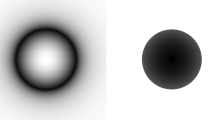Abstract
It is shown that an approach to quantum phenomena in which charged particles are treated as macroscopically extended periodic disturbances in a nonlinear c-number field, interacting with each other via massless excitations of that field, leads almost uniquely to the five basic equations of classical electrodynamics: the Lorentz force law and Maxwell's equations. The fundamental electromagnetic quantity in this approach is the 4-vector potential Aα—interpreted absolutely as a measure of the local shift of each particle off its mass shell—rather than theE andB fields, and it thus provides a new viewpoint on the questions of Aharonov-Bohm phase shifts, the existence of magnetic monopoles, and the role of gauge invariance.
Similar content being viewed by others
References
J. C. Maxwell,Philos. Trans. R. Soc. London 155, 459 (1865);A Treatise on Electricity and Magnetism (Clarendon Press, Oxford, 1873).
J. D. Jackson,Classical Electrodynamics, 2nd ed. (Wiley, New York, 1975).
A. Einstein,Ann. Phys. 49, 769 (1916); W. Pauli,The Theory of Relativity (translation by G. Field of 1921 article) (Pergamon, London, 1958).
J. W. G. Wignall,Found. Phys. 18, 591 (1988).
For a collection of key papers see J. A. Wheeler and W. H. Zurek,Quantum Theory and Measurement (Princeton University Press, Princeton, 1983); for annotated bibliographies see B. S. Dewitt and R. N. Graham,Am. J. Phys 39, 724 (1971) and L. E. Ballentine,Am. J. Phys. 55, 785 (1987).
P. A. M. Dirac,Principles of Quantum Mechanics, 4th ed. (Oxford University Press, Oxford, 1958); R. P. Feynman and A. R. Hibbs,Quantum Mechanics and Path Integrals (McGraw-Hill, New York, 1965).
J. W. G Wignall,Found. Phys. 15, 207 (1985).
J. W. G. Wignall,Found. Phys. 17, 123 (1987).
A. Messiah,Quantum Mechanics (North-Holland, Amsterdam, 1961); W. H. Furry,Boulder Lectures in Theoretical Physics, Vol. 5 (Interscience, New York, 1963); H. M. Bradford,Am. J. Phys. 44, 1058 (1976).
B. Rossi,High Energy Particles (Prentice-Hall, Englewood Cliffs, New Jersey, 1952).
J. W. G. Wignall, “Empirical Limits on the Sizes of Wave Packets in Visual Track Detectors,” University of Melbourne Report UM-P-88/98 (unpublished).
Y. Aharonov and D. Bohm,Phys. Rev. 115, 485 (1959).
R. G. Chambers,Phys. Rev. Lett. 5, 3 (1960); A. Tonomuraet al., Phys. Rev. Lett. 48, 1443 (1982); N. Osakabeet al., Phys. Rev. A 34, 815 (1986).
B. Cabrera,Phys. Rev. Lett. 48, 1378 (1982); B. Cabrera, M. Taber, R. Gardner, and J. Bourg,Phys. Rev. Lett. 51, 1933 (1983); A. D. Caplin, M. Hardiman, M. Koratzinos, and J. C. Schouten,Nature (London)321, 402 (1986); D. E. Groom,Phys. Rep. 140, 323 (1986).
P. A. M. Dirac,Proc. R. Soc. London A 133, 60 (1931),Phys. Rev. 74, 817 (1948).
T. T. Wu and C. N. Yang,Phys. Rev. D 12, 3845 (1975).
Author information
Authors and Affiliations
Rights and permissions
About this article
Cite this article
Wignall, J.W.G. Maxwell electrodynamics from a theory of macroscopically extended particles. Found Phys 20, 139–158 (1990). https://doi.org/10.1007/BF00731644
Received:
Revised:
Issue Date:
DOI: https://doi.org/10.1007/BF00731644



